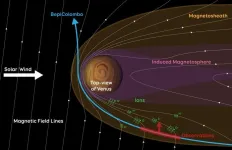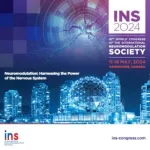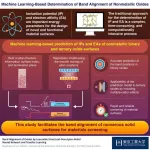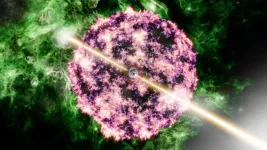(Press-News.org) Approximately one in seven couples face difficulties conceiving a child naturally. Half of these cases are due to male infertility – either caused by the complete absence or low number of mature sperm. In today’s clinical practice, over half of these cases remain unexplained, hindering optimal counselling, treatment, and prevention of potential comorbidities. Known genetic factors account for ~10% of male infertility; however, it is believed that a large portion of unexplained cases of spermatogenic failure are caused by genetic defects that are not analysed in the current clinical workup.
The team led by Prof. Maris Laan (Institute of Biomedicine and Translational Medicine, University of Tartu) and Prof. Margus Punab (Andrology Clinic, Tartu University Hospital) set forward to identify the proportion of male infertility that is caused by a single defective gene. Genetic variation in 638 candidate genes linked to various forms of male infertility were analysed in 521 men with unexplained spermatogenic failure and 323 fertile men recruited to the ESTonian ANDrology (ESTAND) cohort.
Heterogenous genetic causes were identified in ~12% of the analysed patients. Disease-causing variants were detected in 39 genes that regulate spermatogenesis, genital development in utero and/or reproductive endocrinology. Notably, some infertility-causing variants were recurrent – identified in more than one patient in the ESTAND cohort or reported in patients from other populations, whereas some patients carried more than one genetic defect contributing to spermatogenic failure.
Since most genes have multiple functions, genetic defects that cause infertility may also play a role in the overall health of a patient. In this study, men with genetic infertility presented a fourfold higher prevalence of early-onset cancer than the general Estonian male population. Therefore, a precise molecular diagnosis is essential to assess and counsel not only about the reproductive health and infertility management, but also about other health risks linked to the identified genetic defect.
This is one of the largest studies conducted on the monogenic causes of male infertility. The study results have already been incorporated into the clinical practice in the Andrology Clinic of Tartu University Hospital in autumn 2022. A molecular diagnostic test based on the male infertility gene panel is offered to all patients with respective medical indications. The test allows for rapid identification of DNA defects in hundreds of genes linked to spermatogenic failure and improvement in the personalised treatment of infertile couples. According to Laan, the availability of gene panel-based tests in male infertility workup outside private practices is currently a rather unique opportunity.
The Andrology Clinic of Tartu University Hospital manages over 95% of infertile men in Estonia. The study cohort was comprised of patients representing diverse forms of severe infertility. Therefore, these population-wide study outcomes have a high potential to be applicable in andrology clinics worldwide.
END
One of the largest male infertility genetic studies improves molecular diagnostics and personalized management of andrology patients
2024-04-12
ELSE PRESS RELEASES FROM THIS DATE:
Decoding the language of cells: Unveiling the proteins behind cellular organelle communication
2024-04-12
In cellular biology, unraveling the complexities of cellular function at the molecular level remains a paramount endeavor. Significant scientific focus has been placed on understanding the interactions at organelle contact sites, especially between mitochondria and the endoplasmic reticulum (ER). These sites are critical hubs for the exchange of essential biomolecules, such as lipids and calcium, which are vital for maintaining cellular homeostasis. Disruptions in this inter-organelle communication are implicated in the onset ...
BepiColombo spies escaping oxygen and carbon in unexplored region of Venus’s magnetosphere
2024-04-12
A fleeting visit of the ESA/JAXA BepiColombo mission to Venus has revealed surprising insights into how gases are stripped away from the upper layers of the planet’s atmosphere.
Detections in a previously unexplored region of Venus’s magnetic environment show that carbon and oxygen are being accelerated to speeds where they can escape the planet’s gravitational pull. The results have been published today in the journal Nature Astronomy.
Lina Hadid, CNRS researcher at the Plasma Physics Laboratory (LPP) and lead author of the study said: “This is the first time ...
International Neuromodulation Society 16th World Congress to be Held in Vancouver in May 2024
2024-04-12
Vancouver, BC – The International Neuromodulation Society (INS) announces its 16th Scientific World Congress in the breathtaking city of Vancouver, Canada, from May 11-16, 2024. This event, "Neuromodulation: Harnessing the Power of the Nervous System," is set to gather over 1,500 experts from over 40 countries –– with researchers presenting more than 460 abstracts –– all dedicated to advancing research, clinical application, and development in the field of neuromodulation.
This multidisciplinary program will draw clinicians, engineers, scientists, post-doctoral fellows, current students, and device manufacturers, and attendees ...
IOF CSA Medal Of Achievement 2024 awarded to Professor Patricia Clark
2024-04-12
The IOF Committee of Scientific Advisors (CSA) Medal of Achievement has been presented to Dr Patricia Clark at the World Congress on Osteoporosis, Osteoarthritis & Musculoskeletal Diseases (WCO-IOF-ESCEO 2024), being held in London, UK from April 11-14, 2024.
The CSA Medal of Achievement honours individuals who have significantly advanced the field of osteoporosis through their original and outstanding scientific contributions, and whose work has helped to increase understanding and awareness of osteoporosis. Candidates are nominated by members ...
ESCEO-IOF Pierre Delmas Medal awarded to Professor Claudia Campusano
2024-04-12
Today, the European Society for Clinical and Economic Aspects of Osteoporosis, Osteoarthritis and Musculoskeletal Diseases (ESCEO) and the International Osteoporosis Foundation (IOF) have awarded the ESCEO-IOF Pierre Delmas Medal to Professor Claudia Campusano, MD, MSc., Professor of Medicine and Endocrinology at the Faculty of Medicine, Universidad de los Andes in Santiago, Chile.
The ESCEO-IOF Pierre Delmas Medal was presented at the World Congress on Osteoporosis, Osteoarthritis and Musculoskeletal Diseases, taking place in London, UK from April 11 to 14, 2024. The award recognizes a researcher who has made outstanding ...
A novel machine learning model for the characterization of material surfaces
2024-04-12
The design and development of novel materials with superior properties demands a comprehensive analysis of their atomic and electronic structures. Electron energy parameters such as ionization potential (IP), the energy needed to remove an electron from the valence band maximum, and electron affinity (EA), the amount of energy released upon the attachment of an electron to the conduction band minimum, reveal important information about the electronic band structure of surfaces of semiconductors, insulators, and dielectrics. The accurate ...
Presence of specific lipids indicate tissue ageing and can be decreased through exercise
2024-04-12
Scientists have discovered that a type of fat accumulates as tissue ages and that this accumulation can be reversed through exercise. Researchers from Amsterdam UMC, together with colleagues from Maastricht UMC+, analysed both mice and human tissue before and after exercise allowing them to draw this conclusion. The results are published today in Nature Aging.
"The idea that we could reverse aging is something that was long considered science fiction, but these findings do allow us to understand a lot more about the ...
Brightest gamma-ray burst of all time came from the collapse of a massive star
2024-04-12
In October 2022, an international team of researchers, including Northwestern University astrophysicists, observed the brightest gamma-ray burst (GRB) ever recorded, GRB 221009A.
Now, a Northwestern-led team has confirmed that the phenomenon responsible for the historic burst — dubbed the B.O.A.T. (“brightest of all time”) — is the collapse and subsequent explosion of a massive star. The team discovered the explosion, or supernova, using NASA’s James Webb Space Telescope (JWST).
While this discovery solves one mystery, another mystery deepens.
The researchers ...
Stellar winds of three sun-like stars detected for the first time
2024-04-12
An international research team led by a researcher from the University of Vienna has for the first time directly detected stellar winds from three Sun-like stars by recording the X-ray emission from their astrospheres, and placed constraints on the mass loss rate of the stars via their stellar winds. The study is currently published in Nature Astronomy.
Astrospheres, stellar analogues of the heliosphere that surrounds our solar system, are very hot plasma bubbles blown by stellar winds into the interstellar medium, a space filled with gas and dust. The ...
Iconic savanna mammals face genetic problems due to fences and roads
2024-04-12
Whether by way of Attenborough, Disney or National Geographic, the iconic scene is familiar to many. The ground trembles and clouds of dust swirl as enormous hordes of large animals thunder across the African savanna, cross rivers en masse and are picked off by lions, hyena and crocodiles. The annual migration of 1.3 million wildebeest through Tanzania’s Serengeti and Kenya’s Masai Mara attracts hundreds of thousands of tourists, and the phenomenon has put the Serengeti on UNESCO's list of World Heritage sites. Besides its majestic sight, the migration of this emblematic species ...








